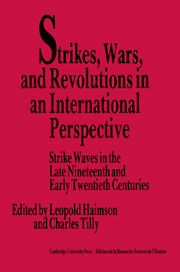 Strikes, Wars, and Revolutions in an International Perspective
Strikes, Wars, and Revolutions in an International Perspective Book contents
- Frontmatter
- Contents
- List of contributors
- Preface
- Part I Introductions
- Part II Models and realities
- Part III Workers in metal-processing enterprises in comparative perspective
- 11 From the mechanic to the metallo
- 12 Strikes of machinists in the United States, 1870–1922
- 13 The political economy of British engineering workers during the First World War
- 14 The rationalization of class struggle: strikes and strike strategy of the German Metalworkers' Union, 1891–1922
- 15 Scientific management and the changing nature of work in the St. Petersburg metalworking industry, 1900–1914
- 16 Structural processes of change and changing patterns of labor unrest: the case of the metal-processing industry in Imperial Russia, 1890–1914
- 17 Social characteristics, attitudes, and patterns of strike behavior of metalworkers in Italy during the First World War
- Part IV The effects of short-term variation
- Part V Conclusion
16 - Structural processes of change and changing patterns of labor unrest: the case of the metal-processing industry in Imperial Russia, 1890–1914
Published online by Cambridge University Press: 25 March 2010
- Frontmatter
- Contents
- List of contributors
- Preface
- Part I Introductions
- Part II Models and realities
- Part III Workers in metal-processing enterprises in comparative perspective
- 11 From the mechanic to the metallo
- 12 Strikes of machinists in the United States, 1870–1922
- 13 The political economy of British engineering workers during the First World War
- 14 The rationalization of class struggle: strikes and strike strategy of the German Metalworkers' Union, 1891–1922
- 15 Scientific management and the changing nature of work in the St. Petersburg metalworking industry, 1900–1914
- 16 Structural processes of change and changing patterns of labor unrest: the case of the metal-processing industry in Imperial Russia, 1890–1914
- 17 Social characteristics, attitudes, and patterns of strike behavior of metalworkers in Italy during the First World War
- Part IV The effects of short-term variation
- Part V Conclusion
Summary
If we turn back the clock to the early 1890s, or more precisely to the sketches drawn for us (largely by radical members of the intelligentsia) of the masterovye, the skilled workers employed in St. Petersburg's mechanical and metalprocessing plants, we can draw a number of concurring generalizations about the characteristics that then distinguished these workers – and more generally the world of the zavodskiye (the workers, skilled and unskilled, employed in various plants of the capital's heavy industries) – from the largely unskilled and lower paid workers employed in the city's light industries, (most of them in textile and food-processing enterprises):
One of these concurring generalizations centers on the learning process involved in skilled metalworkers' mastering of their trade and the key role that this process of mastering ultimately played in these workers' gains of greater autonomy in the production process, as well as in their economic, social, and cultural advancement. Greater autonomy because, in the semiartisanal conditions that still distinguished the operations of St. Petersburg's mechanical and other metal-processing plants (including even the larger ones), the acquisition of the various skills attendant on the mastery of the trade implied for a machinist and other skilled workers employed in mechanical and other metal-processing plants the assumption of greater control over their own work: greater independence in the exercise of the various decisions involved in the work process, in the tempo at which this work was performed, and more generally in the degree of freedom attained in this work performance from interference by supervisory personnel.
Information
- Type
- Chapter
- Information
- Strikes, Wars, and Revolutions in an International PerspectiveStrike Waves in the Late Nineteenth and Early Twentieth Centuries, pp. 380 - 401Publisher: Cambridge University PressPrint publication year: 1989